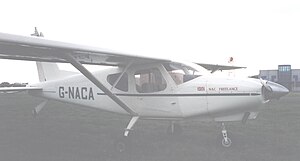NAC Freelance
| NAC-1 (BN-3) Freelance | |
|---|---|

| |
| The NAC-2 Freelance 180 (similar to NAC-1) at Coventry airport, England, in June 2003 | |
| Role | Four-seat monoplane |
| National origin | United Kingdom |
| Manufacturer | Britten-Norman NDN Aircraft Norman Aircraft Company |
| Designer | Desmond Norman |
| First flight | 17 May 1969 (BN-3) 29 September 1984 (NAC-1)[1] |
| Status | operational in 2003, now stored |
| Number built | 2 |
The NAC-1 Freelance originally the BN-3 Nymph is a British four-seat touring monoplane.
Development
Designed by Desmond Norman when with Britten-Norman the BN-3 Nymph was an all-metal high-wing braced monoplane powered by a 115 hp Lycoming O-235 engine. It was designed to allow it to be assembled in under-developed countries which would build the aircraft under a technology transfer scheme.[2]
With the demise of the original Britten-Norman company, Norman took the design with him to his new company NDN Aircraft. NDN planned to build and sell the Nymph with a lengthened cabin as the NAC-1 Freelance. The Nymph was reworked as the prototype Freelance and first flew in that configuration on 29 September 1984.[1] In 1985 NDN Aircraft was renamed the Norman Aircraft Company (NAC) and components and fuselage sections for six aircraft were built. Following the failure of the company to win a military order with the NDN Firecracker military trainer the company was closed down.
Specifications (BN-3)
Data from Jane's All The World's Aircraft 1969–70[2]
General characteristics
- Crew: 1
- Capacity: 3 passengers
- Length: 23 ft 7 in (7.20 m)
- Wingspan: 39 ft 4 in (11.98 m)
- Height: 9 ft 6 in (2.90 m)
- Wing area: 169.0 sq ft (15.70 m2)
- Aspect ratio: 9.1:1
- Airfoil: NACA 23012
- Empty weight: 1,140 lb (517 kg)
- Max takeoff weight: 1,925 lb (873 kg)
- Powerplant: 1 × Lycoming O-235-C1B air-cooled flat-four, 115 hp (86 kW)
- Propellers: 2-bladed Sensenich, 6 ft 2 in (1.88 m) diameter
Performance
- Maximum speed: 117 mph (188 km/h, 102 kn) at sea level
- Cruise speed: 113 mph (182 km/h, 98 kn) at 7,500 ft (2,300 m)
- Range: 600 mi (970 km, 520 nmi)
- Service ceiling: 11,200 ft (3,400 m)
- Rate of climb: 600 ft/min (3.0 m/s)
- Take-off run to 50 ft (15 m): 1,550 ft (470 m)
- Landing run from 50 ft (15 m): 920 ft (280 m)
References
- Jackson, A.J. (1973). British Civil Aircraft since 1919 Volume 1. London: Putnam. ISBN 0-370-10006-9.
{{cite book}}: Cite has empty unknown parameter:|coauthors=(help) - Simpson, Rod (2001). Airlife's World Aircraft. Airlife Publishing Ltd. ISBN 1-84037-115-3.
- Taylor, John W. R. (1969). Jane's All The World's Aircraft 1969–70. London: Sampson Low, Marston & Co. Ltd.
- Taylor, Michael J. H. (1989). Jane's Encyclopedia of Aviation. London: Studio Editions.
